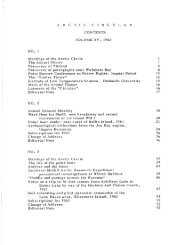Volume 11, 1958 - The Arctic Circle - Home
Volume 11, 1958 - The Arctic Circle - Home
Volume 11, 1958 - The Arctic Circle - Home
You also want an ePaper? Increase the reach of your titles
YUMPU automatically turns print PDFs into web optimized ePapers that Google loves.
VOL. XI No.4<br />
THE ARCTIC CIRCULAR<br />
67<br />
On Mansel Island six sites were found in a very<br />
restricted area about the river valley. Four of these were pure<br />
Dorset culture in content and representative of various stages<br />
in the development of that culture. A fifth site contained both<br />
Dorset and later houses and artifacts. A sixth site, extending<br />
along the river bank for hali a mile. was pure Dorset culture<br />
in some areas and mixed in others. Again,houses of more than<br />
one period were represented. <strong>The</strong> most significant preliminary<br />
results of the Mansel Island work were (a) a Dorset site that<br />
seems to be typologically earlier than the proto-Dorset site,<br />
T-l, on Southampton Island (Henry B. Collins, ~. Rept. ~.<br />
Mus. Can. Bull. No. 14Z, 1956); (b) the finding of many Dorset<br />
cultur~use ruins, and (c) the recovery, in a pure Dorset<br />
culture site, of human skeletal material including a mandible and<br />
a femur - only the second find of analysable human bone in a<br />
Dorset culture context.<br />
On Sugluk Island work was continued on proto-Dorset<br />
and terminal Dorset period sites dHicovered in 1957. Significant<br />
in this was the excavation of a late-period Dorset culture house<br />
ruin. In addition a fourth site was found On this little island and<br />
it proved to be the most enlightening of the season. It consisted<br />
of three superimposed culture strata, the topmost of which<br />
contained proto-Dorset material; the lower layers were earlier<br />
but also proto-Dorset in typology. Excavation was not carried<br />
beyond the third stratum because of permafrost at a depth of<br />
four feet.<br />
-<br />
•<br />
In the top stratum of this site a human mandible and<br />
three ribs were found. <strong>The</strong>se are, for the moment, the oldest<br />
human bones excavated in the North American <strong>Arctic</strong> and have<br />
been dated by radiocarbon analysis to 500 B.C. Both this<br />
mandible, from an early Dorset period, and the mandible from<br />
Mansel Island are morphologically Eskimo. <strong>The</strong> same may be<br />
said of the skeleton excavated at a Dorset site near Payne Bay<br />
in 1957 (<strong>Arctic</strong> Circular, Vol. 10, pp. Z5-7). <strong>The</strong>se constitute<br />
the only analysable human remains from the Dorset period.<br />
Though the sample is small, it is consistent, and provides<br />
convincing evidence against the theory of an Indian migration<br />
as the origin of the Dorset culture, formerly held by several<br />
Eskimologists •<br />
<strong>The</strong> small village site at "Eeteevianee" belongs in<br />
the middle of the Dorset time span. <strong>The</strong> most remarkable<br />
observation on this site was the high incidence of seal bones,<br />
which totalled more than 90 per cent of the animal bone sample.












